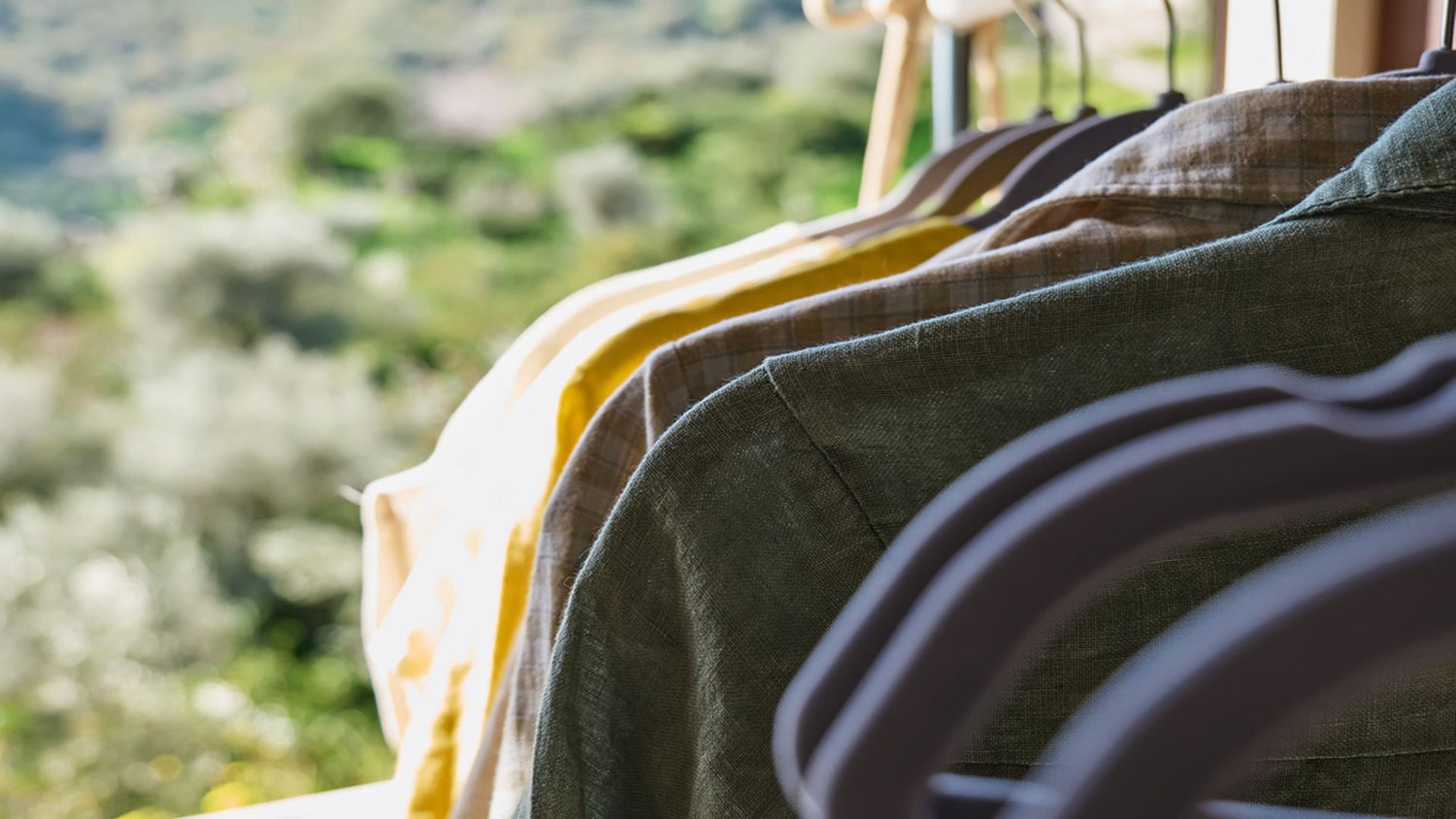Lark & Berry's Match is proud to only work with and promote brands that take care towards sustainability in their design and/or manufacturing methods.
You wouldn't be here reading this if you weren't something of a fashionista, looking for the next cool movement in luxury. And we're also betting that you know something about sustainable fashion given that you care for the future of our planet.
But the worlds of sustainable fashion and jewellery are growing and changing so fast, it can be hard to keep up with everything happening.
Sustainable fashion, for instance, isn't as simple (relatively speaking) as lab-grown diamonds vs. mined diamonds, like with our parent brand, Lark & Berry. With sustainability in fashion, there are so many moving parts - everything from the use of deadstock fabrics, bamboo as a material, Tencel, terms like "slow" and "fast" fashion and green-washing... confused yet? Don't worry, we have you covered!
Let's settle in and learn all about sustainable fashion!

Sustainability in fashion has become a trending topic in recent years as people around the world become more conscious of the impact that the fashion industry has on the environment. As consumers become more aware of the negative impact that fast fashion has on the planet, they are looking for ways to shop sustainably and support ethical brands. This has led to a significant shift in the fashion industry as companies are forced to re-evaluate their practices and prioritize sustainability.
One of the biggest factors driving the trend towards sustainable fashion is the growing awareness of the environmental impact of the fashion industry. The production and distribution of clothing have a significant impact on the environment, from the use of non-renewable resources like oil and water to the pollution caused by textile dyeing and finishing processes. The "fast fashion" model, in particular, has been widely criticized for its wastefulness, with clothing items often discarded after only a few wears.
This blog isn't for "naming names" but if you're wondering which clothing brands/retailers are fast fashion... just think of all the biggest names, and you'll be pretty much right on the money - such as the stores you'd see in particularly touristy areas of a city, in shopping malls and at outlet malls. Some of these brands are making efforts to change their ways to be more sustainable, but most are still roundly criticized for not doing enough.

Consumers are starting to realize that their choices have consequences, and they are looking for ways to reduce their impact on the planet.
According to a 2021 survey conducted by the global fashion search platform Lyst, sustainability-related searches increased by 37% compared to the previous year.
Another factor driving the trend towards sustainability in fashion is the rise of ethical consumerism. Consumers are increasingly interested in the social and ethical implications of their purchases, and they want to support companies that share their values. This has led to a surge in demand for clothing that is made using ethical labour practices and materials that are sustainably sourced. Consumers are also looking for brands that are transparent about their supply chains and environmental impact, so they can make informed choices about what they buy.
As the trend towards sustainability in fashion continues to grow, many brands are starting to take notice. Companies are realizing that they need to change their practices to stay relevant and meet the demands of their customers. This has led to a wave of innovation in the fashion industry, with new materials and production methods being developed to reduce the environmental impact of clothing production.
Some brands are focusing on using sustainable materials, such as organic cotton or recycled polyester, in their clothing. Others are prioritizing ethical labour practices, ensuring that the people who make their clothing are treated fairly and paid a living wage. Some companies are even using technology to reduce their environmental impact, such as by using waterless dyeing processes or creating clothing from recycled materials.

Let's stop here to take a deeper dive into some of the sustainable materials/methods that brands like those represented by Lark & Berry's Match are using to create their fashion…
1. Use of deadstock fabrics
We wanted to kick off this list with the use of deadstock fabric in sustainable fashion for a reason – it’s probably one of the methods/terms you’ll see mentioned the most in the world of environmentally responsible clothing.
Deadstock refers to excess fabric that has not been used by a fashion brand or manufacturer and is often sold off to third-party vendors. In the past, this excess fabric was often discarded or left in storage, creating a waste problem for the fashion industry. However, in recent years, there has been a growing trend of using deadstock fabrics in fashion.
One interesting aspect of using deadstock fabric is that it is often limited in quantity, meaning that the resulting garments are unique and exclusive. This has led to a rise in demand for deadstock fabrics and has spurred the creation of small-batch, sustainable fashion brands that specialize in using these materials.
Another interesting aspect of using deadstock fabric is that it can help reduce the environmental impact of the fashion industry. By using existing fabric instead of producing new fabric, deadstock helps reduce the amount of water, energy, and other resources needed to produce new textiles. Additionally, by repurposing deadstock fabrics, fashion brands can help reduce textile waste and landfill pollution.
2. Organic cotton
This is cotton that is grown without the use of harmful chemicals or pesticides, making it a sustainable and environmentally friendly option. Organic cotton is soft, breathable, and durable, making it a popular choice for clothing, especially basics like t-shirts and jeans.
3. Linen
Buying sustainably and the movements surrounding it are new, but linen in clothing certainly is not… who knew all this time we were being sustainable by supporting and wearing it!
Turns out, linen is a natural fibre made from the flax plant. It is one of the oldest and most sustainable fabrics, as it requires less water and energy to produce than other fibres. Linen is lightweight, breathable, and has a unique texture, making it perfect for summer clothing like dresses and skirts.
4. Hemp
There have been movements to promote hemp more for creating all sorts of materials, not just clothing… but people are finally listening.
Hemp is a sustainable and versatile fabric that is made from the fibres of the hemp plant. It is strong, durable, and grows quickly, making it a great alternative to traditional cotton. Hemp is also resistant to mould, mildew, and UV light, making it ideal for outdoor clothing like jackets and backpacks.
5. Tencel
Tencel is a sustainable fabric made from wood pulp that is harvested from responsibly managed forests. It is soft, breathable, and biodegradable, making it an eco-friendly alternative to synthetic fabrics like polyester. Tencel is often used in clothing like shirts, dresses, and jumpsuits.

6. Recycled Polyester
Polyester is one of the most commonly used fabrics in clothing production, but it is not sustainable because it is made from petroleum-based chemicals. Recycled polyester, on the other hand, is made from post-consumer plastic bottles and other recycled materials, making it a more eco-friendly option. Recycled polyester is often used in clothing like activewear and swimwear.
7. Bamboo
Bamboo is a sustainable fabric that is made from the pulp of bamboo plants. It is soft, lightweight, and has natural anti-bacterial properties, making it a popular choice for activewear and underwear. However, it is important to note that some bamboo fabrics are processed with harmful chemicals, so it is important to look for bamboo fabrics that are certified organic.
8. Wool
Another fabric you’ve probably been wearing for years, not even realizing you’re doing something good for the planet!
Wool is a natural and sustainable fibre that is often used in clothing like sweaters and coats. It is warm, breathable, and biodegradable, making it a great choice for winter clothing. However, it is important to look for wool that is ethically sourced and produced, as some wool production practices can be harmful to animals and the environment.
Green-washing: What it is and how to watch out for it.

As the world becomes increasingly aware of the environmental impact of our actions, many companies have started marketing themselves as “green” or “sustainable” to appeal to environmentally-conscious consumers. This phenomenon is known as “green-washing,” and fashion consumers need to be cautious and informed about the products they buy.
Green-washing can take many forms, from using vague or misleading language to make a product appear more environmentally friendly than it is, to using green packaging or labels without actually changing the production process or materials used. It can be difficult for consumers to navigate these claims, but there are a few things to keep in mind when shopping for sustainable fashion.
First, do your research. Look for brands that are transparent about their production process and materials used, and who have certifications or third-party verification for their sustainability claims. Don’t just take their word for it; look for evidence to back up their claims.
Second, be wary of vague or misleading language. Terms like “eco-friendly” or “green” can be used in a variety of ways, and may not mean much in terms of sustainability.
Look for specific claims, such as the use of organic or recycled materials, or a reduction in water or energy usage during production.
Third, consider the overall impact of a product. Even if a product is made from sustainable materials, it may still have a high carbon footprint due to transportation or production processes. Look for products that are produced locally, or that have a clear plan for reducing their carbon footprint.
Finally, remember that the most sustainable option is often to simply buy less. Instead of constantly buying new clothes, consider investing in high-quality pieces that will last for years, or shop secondhand to give existing clothes a new life.
Being a responsible and informed fashion consumer takes effort, but it’s an important step in reducing our impact on the environment. By being cautious about green-washing and supporting truly sustainable brands, we can help create a more sustainable future for ourselves and the planet.
In addition to the changes being made by legitimately environmentally responsible brands, there are also brand collectives doing great work to promote sustainability and great design as widely as possible…
We can’t help but want to mention and remind here about yours truly, Lark & Berry's Match! The platform brings together sustainability-minded brands with excellent and unique designs from all over the world. It’s one of the biggest, far-reaching, high-end collections of luxury fashion, jewellery and accessories out there, and we’re proud!
Despite the progress being made towards sustainability in fashion, there is still a long way to go.
The fast fashion model is still dominant, and many consumers are still drawn to cheap clothing that is not made sustainably. However, the trend towards sustainability in fashion is growing, and as more consumers become aware of the impact of their choices, this trend will likely continue.
Sustainability in fashion is a trending topic that is driven by a growing awareness of the environmental and social impact of the fashion industry. Consumers are looking for ways to reduce their impact on the planet and support ethical brands, leading to a shift in the fashion industry towards more sustainable practices. Getting started in helping the planet is easy as shopping with sustainability-minded brands!





Leave a comment
This site is protected by hCaptcha and the hCaptcha Privacy Policy and Terms of Service apply.